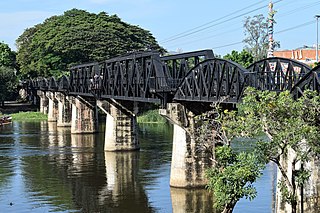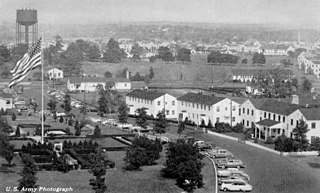Related Research Articles

The Burma Railway, also known as the Siam–Burma Railway, Thai–Burma Railway and similar names, or as the Death Railway, is a 415 km (258 mi) railway between Ban Pong, Thailand, and Thanbyuzayat, Burma. It was built from 1940 to 1943 by civilian laborers impressed or recruited by the Japanese and prisoners of war taken by the Japanese, to supply troops and weapons in the Burma campaign of World War II. It completed the rail link between Bangkok, Thailand, and Rangoon, Burma. The name used by the Japanese Government was Tai–Men Rensetsu Tetsudō (泰緬連接鉄道), which means Thailand-Burma-Link-Railway.

Fort Novosel is a United States Army post located primarily in Dale County, Alabama, United States. It is named in honor of Chief Warrant Officer Michael J. Novosel, an Army aviator and medal of honor recipient. It was previously named for a Civil War officer, Confederate Colonel Edmund Rucker. The post is the primary flight training installation for U.S. Army Aviators and is home to the United States Army Aviation Center of Excellence (USAACE) and the United States Army Aviation Museum. Small sections of the post also lie in Coffee, Geneva, and Houston counties. Part of the Dale County section of the base is a census-designated place; its population was 4,636 at the 2010 census.

Fort Oglethorpe is a city predominantly in Catoosa County with some portions in Walker County in the U.S. state of Georgia. As of the 2020 census, the city had a population of 10,423. It is part of the Chattanooga, TN–GA Metropolitan Statistical Area. It is home to Lakeview – Fort Oglethorpe High School.

New Haven is a city in Adams, Jefferson, and St. Joseph townships, Allen County, Indiana, United States. It sits to the east of the city of Fort Wayne, the second largest city in Indiana, and is situated mostly along the southern banks of the Maumee River. The population was 14,794 as of the 2010 census.

Fort McCoy is a United States Army installation on 60,000 acres (24,000 ha) between Sparta and Tomah, Wisconsin, in Monroe County. In 1909, there were two separate camps named Camp Emory Upton and Camp Robinson; in 1926, these camps were joined together to form Camp McCoy. Since its creation in 1909, the post has been used primarily as a military training center. A part of Fort McCoy is also used by the Wisconsin State Patrol as a training facility.

William Wallace Atterbury was a brigadier general in the United States Army during World War I, who began his career with the Pennsylvania Railroad (PRR) in 1886 and rose through the ranks to become its tenth president (1925–1935). As director-general of transportation in France during the war, the New Albany, Indiana, native and Yale University graduate was instrumental in reorganizing railroad traffic for more efficient transportation of troops and supplies for the American Expeditionary Forces. He was also known as "The Railroad General". Under his leadership after the war, the Pennsylvania Railroad undertook a $250 million project to electrify major portions of its main line that ran between New York City and Washington, D.C. He also assisted in development of the company's first M1-class steam locomotive.

Thomas Alexander Scott was an American businessman, railroad executive, and industrialist. In 1861, President Abraham Lincoln appointed him to serve as U.S. Assistant Secretary of War, and during the American Civil War railroads under his leadership played a major role in the war effort. He became the fourth president of the Pennsylvania Railroad (1874–1880), which became the largest publicly traded corporation in the world and received much criticism for his conduct in the Great Railroad Strike of 1877 and as a "robber baron." Scott helped negotiate the Republican Party's Compromise of 1877 with the Democratic Party; it settled the disputed presidential election of 1876 in favor of Rutherford B. Hayes in exchange for the federal government pulling out its military forces from the South and ending the Reconstruction era. In his final years, Scott made large donations to the University of Pennsylvania.

Located in Central New Jersey, Camp Kilmer is a former United States Army camp that was activated in June 1942 as a staging area and part of an installation of the New York Port of Embarkation. The camp was organized as part of the Army Service Forces Transportation Corps. Troops were quartered at Camp Kilmer in preparation for transport to the European Theater of Operations in World War II. Eventually, it became the largest processing center for troops heading overseas and returning from World War II, processing over 2.5 million soldiers. It officially closed in 2009.

Nickel Plate Road 765 is a class "S-2" 2-8-4 "Berkshire" type steam locomotive built for the New York, Chicago & St. Louis Railroad, commonly referred to as the "Nickel Plate Road". In 1963, No. 765, renumbered as 767, was donated to the city of Fort Wayne, Indiana, where it sat on display at the Lawton Park, while the real No. 767 was scrapped in Chicago in 1964.
Northern Arrow was one of the named passenger trains of the Pennsylvania Railroad, starting at Cincinnati, Ohio and ending at Mackinaw City, Michigan. It had merging branches originating from Chicago, Illinois, converging in Fort Wayne, Indiana, and a train from St. Louis, Missouri from the west, converging at Richmond, Indiana. Carrying the number #519 northbound and #520 southbound, it used the Grand Rapids and Indiana Railroad, a leased subsidiary of the Pennsylvania system.

Camp Shanks was a United States Army installation in the Orangetown, New York area. Named after Major General David C. Shanks, it was situated near the juncture of the Erie Railroad and the Hudson River. The camp was the largest U.S. Army embarkation camp used during World War II.

Camp Atterbury-Muscatatuck is a federally-owned military post, licensed to and operated by the Indiana National Guard, located in south-central Indiana, 4 miles (6.4 km) west of Edinburgh, Indiana and U.S. Route 31. The camp's mission is to provide full logistical and training support for up to two brigade-sized elements simultaneously. The Camp offers a variety of training ranges, live-fire venues, managed airspace with air-to-ground fighting capabilities and an LVC simulation and exercise center. It is also the normal Annual Training location for National Guard and Reserve forces located in Indiana.
Camp Patrick Henry is a decommissioned United States Army base which was located in Warwick County, Virginia. After World War II, the site was redeveloped as a commercial airport, and became part of City of Newport News in 1958 when the former City of Warwick and Newport News were politically consolidated as a single independent city. The airport is known in modern times as Newport News/Williamsburg International Airport.
During the American Civil War, Indianapolis, the state capital of Indiana, was a major base of supplies for the Union. Governor Oliver P. Morton, a major supporter of President Abraham Lincoln, quickly made Indianapolis a gathering place to organize and train troops for the Union army. The city became a major railroad hub for troop transport to Confederate lands, and therefore had military importance. Twenty-four military camps were established in the vicinity of Indianapolis. Camp Morton, the initial mustering ground to organize and train the state's Union volunteers in 1861, was designated as a major prisoner-of-war camp for captured Confederate soldiers in 1862. In addition to military camps, a state-owned arsenal was established in the city in 1861, and a federal arsenal in 1862. A Soldiers' Home and a Ladies' Home were established in Indianapolis to house and feed Union soldiers and their families as they passed through the city. Indianapolis residents also supported the Union cause by providing soldiers with food, clothing, equipment, and supplies, despite rising prices and wartime hardships, such as food and clothing shortages. Local doctors aided the sick, some area women provided nursing care, and Indianapolis City Hospital tended to wounded soldiers. Indianapolis sent an estimated 4,000 men into military service; an estimated 700 died during the war. Indianapolis's Crown Hill National Cemetery was established as one of two national military cemeteries established in Indiana in 1866.
Camp Thomas was a United States Regular Army training facility located in North Columbus, Ohio, during the American Civil War. It was primarily used to organize and train new infantry regiments for service in the Western Theater.

Camp Harahan, also called Camp Plauche, was a troop staging area outside New Orleans, Louisiana during World War II.

The Pennsylvania Railroad Station in Fort Wayne, Indiana, also known as Baker Street Station, is a former passenger rail station in downtown Fort Wayne, Indiana. The American Craftsman-style station opened to the public March 23, 1914, at a cost of $550,000.

Grands Rapids Union Station was a union station in Grand Rapids, Michigan. A Georgian Revival building of two stories, it was built in 1900 and was closed in 1958 and demolished over 1958 and 1959 to make space for a highway. Its address was 61 Ionia Avenue. It was a hub serving a few railroads going to different points in Michigan and other points in the Midwest.

Camp Nong Pladuk was a Japanese prisoner of war transit camp during World War II. It was located about five kilometres from the main railway station of Ban Pong near a junction station on the Southern Line to Bangkok. Nong Pladuk served as the starting point of the Burma Railroad. Numerous British, Dutch, and allied troops passed through Nong Pladuk to construct the railroad. Nowadays, it serves as a rail road maintenance and repair facility.
References
- 1 2 3 Eastes, Erick E. (1986). "'A By-Product of War': A History of Camp Thomas A. Scott 1942-1949". Old Fort News.
- 1 2 3 4 5 Hawfield, Michael (December 15, 1990). "World War II Camp Had Impact on City". News-Sentinel.
- ↑ "Railroaders in Olive Drab: The Military Railway Service in WWII – the Campaign for the National Museum of the United States Army".
- ↑ Schwier, Ryan (August 31, 2015). ""Eden for Enemy Prisoners": The Role of International Humanitarian Law in Indiana During World War II". Indiana Legal Archive.
- ↑ "Allen County Public Library".
- ↑ Fort Wayne, City of (January 1946). "Huts to Houses for Vets at Camp Scott". Fort Wayne Municipal Review.
- ↑ https://www.cityoffortwayne.org/images/stories/Utilities/docs/csbrochure.pdf [ bare URL PDF ]
- ↑ "Camp Scott Wetlands - City of Fort Wayne".
- Eastes, Erick E. "'A By-Product of War': A History of Camp Thomas A. Scott 1942-1949" Old Fort News 49.2 (1986).
- Hawfield, Michael. "World War II Camp Had Impact on City" The News-Sentinel 15 December 1990.
- Camp Thomas A. Scott - Fort Wayne, Indiana - World War II Prisoner of War Camps on Waymarking.com
- http://explorepahistory.com/story.php?storyId=1-9-10&chapter=1
Coordinates: 41°03′27″N85°05′48″W / 41.057495°N 85.096570°W